View in other NatureServe Network Field Guides
NatureServe
Montana
Utah
Wyoming
Idaho
Wisconsin
British Columbia
South Carolina
Yukon
California
New York
Fanleaf Cinquefoil - Potentilla gracilis
Other Names:
Northwest Cinquefoil
Native Species
Global Rank:
G5
State Rank:
S5
(see State Rank Reason below)
C-value:
4
Agency Status
USFWS:
USFS:
BLM:
External Links
State Rank Reason (see State Rank above)
Common in a variety of open habitats in the western half of the state.
General Description
Perennial from a mostly branched caudex. Stems erect or ascending, glabrate to pubescent, subscapose, 10–60 cm. Leaf blades suborbicular, palmately divided into 5 to 9 oblanceolate, dentate to deeply lobed, glabrous to tomentose leaflets 2–8 cm long. Inflorescence a many-flowered, sericeous, sometimes glandular, open cyme with ascending branches. Flowers: sepals lanceolate, 3–8 mm long; bracteoles narrower and shorter; petals yellow, 5–10 mm long. Achenes smooth, 1–1.5 mm long (
Lesica et al. 2012. Manual of Montana Vascular Plants. BRIT Press. Fort Worth, TX).
Lesica (2012) recognizes five varieties in MT: var.
brunnescens (Rydb.) C.L. Hitchc.; var.
fastigiata (Nutt.) S. Watson; var.
elmeri (Rydb.) Jeps.; var.
flabelliformis (Lehm.) Nutt. ex Torr. & A. Gray; and var.
pulcherimma (Lehm.) Fernald. At the present time MT NHP is only recognizing varieties
flabelliformis and
pulcherrima.
Species Range
Montana Range
Range Descriptions
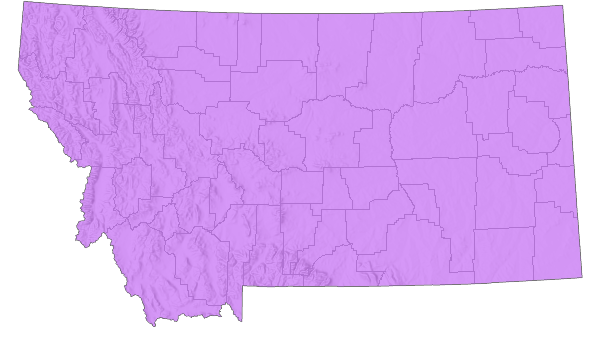
 Native
Native
Range Comments
AK to MB south to CA, AZ and NM (Lesica et al. 2012. Manual of Montana Vascular Plants. BRIT Press. Fort Worth, TX).
Observations in Montana Natural Heritage Program Database
Number of Observations: 1973
(Click on the following maps and charts to see full sized version)
Map Help and Descriptions
Relative Density
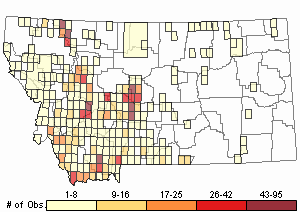
Recency
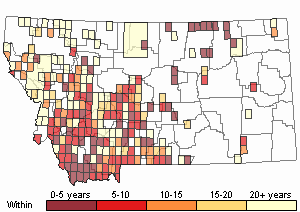

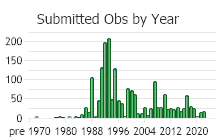
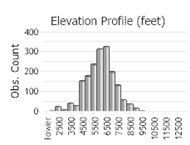 (Observations spanning multiple months or years are excluded from time charts)
(Observations spanning multiple months or years are excluded from time charts)
Habitat
National Vegetation Classification System Groups Associated with this Species
Grassland
Lowland - Prairie Grassland
Montane - Subalpine Grassland
Ecology
POLLINATORS The following animal species have been reported as pollinators of this plant species or its genus where their geographic ranges overlap:
Bombus bifarius,
Bombus fervidus,
Bombus frigidus,
Bombus rufocinctus,
Bombus occidentalis,
Bombus pensylvanicus,
Bombus impatiens, and
Bombus flavidus (Thorp et al. 1983, Wilson et al. 2010, Colla and Dumesh 2010, Colla et al. 2011, Koch and Strange 2012, Koch et al. 2012, Williams et al. 2014).
Stewardship Responsibility
References
- Literature Cited AboveLegend:
 View Online Publication
View Online Publication Colla, S., L. Richardson, and P. Williams. 2011. Bumble bees of the eastern United States. Washington, DC: USDA Forest Service, Pollinator Partnership. 103 p.
Colla, S., L. Richardson, and P. Williams. 2011. Bumble bees of the eastern United States. Washington, DC: USDA Forest Service, Pollinator Partnership. 103 p. Colla, S.R. and S. Dumesh. 2010. The bumble bees of southern Ontario: notes on natural history and distribution. Journal of the Entomological Society of Ontario 141:39-68.
Colla, S.R. and S. Dumesh. 2010. The bumble bees of southern Ontario: notes on natural history and distribution. Journal of the Entomological Society of Ontario 141:39-68. Koch, J., J. Strange, and P. Williams. 2012. Bumble bees of the western United States. Washington, DC: USDA Forest Service, Pollinator Partnership. 143 p.
Koch, J., J. Strange, and P. Williams. 2012. Bumble bees of the western United States. Washington, DC: USDA Forest Service, Pollinator Partnership. 143 p. Koch, J.B. and J.P. Strange. 2012. The status of Bombus occidentalis and B. moderatus in Alaska with special focus on Nosema bombi incidence. Northwest Science 86:212-220.
Koch, J.B. and J.P. Strange. 2012. The status of Bombus occidentalis and B. moderatus in Alaska with special focus on Nosema bombi incidence. Northwest Science 86:212-220. Lesica, P., M.T. Lavin, and P.F. Stickney. 2012. Manual of Montana Vascular Plants. Fort Worth, TX: BRIT Press. viii + 771 p.
Lesica, P., M.T. Lavin, and P.F. Stickney. 2012. Manual of Montana Vascular Plants. Fort Worth, TX: BRIT Press. viii + 771 p. Thorp, R.W., D.S. Horning, and L.L. Dunning. 1983. Bumble bees and cuckoo bumble bees of California (Hymenoptera: Apidae). Bulletin of the California Insect Survey 23:1-79.
Thorp, R.W., D.S. Horning, and L.L. Dunning. 1983. Bumble bees and cuckoo bumble bees of California (Hymenoptera: Apidae). Bulletin of the California Insect Survey 23:1-79. Williams, P., R. Thorp, L. Richardson, and S. Colla. 2014. Bumble Bees of North America. Princeton, NJ: Princeton University Press. 208 p.
Williams, P., R. Thorp, L. Richardson, and S. Colla. 2014. Bumble Bees of North America. Princeton, NJ: Princeton University Press. 208 p. Wilson, J.S., L.E. Wilson, L.D. Loftis, and T. Griswold. 2010. The montane bee fauna of north central Washington, USA, with floral associations. Western North American Naturalist 70(2): 198-207.
Wilson, J.S., L.E. Wilson, L.D. Loftis, and T. Griswold. 2010. The montane bee fauna of north central Washington, USA, with floral associations. Western North American Naturalist 70(2): 198-207.
- Additional ReferencesLegend:
 View Online Publication
View Online Publication
Do you know of a citation we're missing? Aho, Ken Andrew. 2006. Alpine and Cliff Ecosystems in the North-Central Rocky Mountains. Ph.D. Dissertation. Bozeman, Montana: Montana State University. 343 p.
Aho, Ken Andrew. 2006. Alpine and Cliff Ecosystems in the North-Central Rocky Mountains. Ph.D. Dissertation. Bozeman, Montana: Montana State University. 343 p. Ament, R.J. 1995. Pioneer Plant Communities Five Years After the 1988 Yellowstone Fires. M.Sc. Thesis. Bozeman, MT: Montana State University. 216 p.
Ament, R.J. 1995. Pioneer Plant Communities Five Years After the 1988 Yellowstone Fires. M.Sc. Thesis. Bozeman, MT: Montana State University. 216 p. Aradottir, A.L. 1984. Ammonia volatilization from native grasslands and forests of SW Montana. M.Sc. Thesis. Bozeman, MT: Montana State University. 48 p.
Aradottir, A.L. 1984. Ammonia volatilization from native grasslands and forests of SW Montana. M.Sc. Thesis. Bozeman, MT: Montana State University. 48 p. Buchanan, B.A. 1972. Ecological effects of weather modification, Bridger Range area, Montana: relationship of soil, vegetation, and microclimate. Ph.D. Dissertation. Montana State University, Bozeman. 130 p.
Buchanan, B.A. 1972. Ecological effects of weather modification, Bridger Range area, Montana: relationship of soil, vegetation, and microclimate. Ph.D. Dissertation. Montana State University, Bozeman. 130 p. Clark, D. 1991. The effect of fire on Yellowstone ecosystem seed banks. M.Sc. Thesis. Montana State University, Bozeman. 115 pp.
Clark, D. 1991. The effect of fire on Yellowstone ecosystem seed banks. M.Sc. Thesis. Montana State University, Bozeman. 115 pp. Conrad, C.C. 1979. Characteristics of Pocket Gopher populations in relation to selected environmental factors in Pelican Valley, Yellowstone National Park. M.Sc. Thesis. Bozeman, Montana: Montana State University. 79 p.
Conrad, C.C. 1979. Characteristics of Pocket Gopher populations in relation to selected environmental factors in Pelican Valley, Yellowstone National Park. M.Sc. Thesis. Bozeman, Montana: Montana State University. 79 p. Cramer, P.C. 1992. Small mammal diversity and abundance in Douglas Fir old growth forests. M.Sc. Thesis. Bozeman, MT: Montana State University. 64 p.
Cramer, P.C. 1992. Small mammal diversity and abundance in Douglas Fir old growth forests. M.Sc. Thesis. Bozeman, MT: Montana State University. 64 p. Dale, D. 1973. Effects of trail use under forests in the Madison Range, Montana. M.Sc. Thesis. Bozeman, MT: Montana State University. 96 pp.
Dale, D. 1973. Effects of trail use under forests in the Madison Range, Montana. M.Sc. Thesis. Bozeman, MT: Montana State University. 96 pp. Eggers, M.J.S. 2005. Riparian vegetation of the Montana Yellowstone and cattle grazing impacts thereon. M.Sc. Thesis. Montana State University, Bozeman, MT. 125 p.
Eggers, M.J.S. 2005. Riparian vegetation of the Montana Yellowstone and cattle grazing impacts thereon. M.Sc. Thesis. Montana State University, Bozeman, MT. 125 p. Fogelsong, M.L. 1974. Effects of fluorides on Peromyscus maniculatus in Glacier National Park. M.Sc. Thesis. Bozeman, Montana: Montana State University. 52 p.
Fogelsong, M.L. 1974. Effects of fluorides on Peromyscus maniculatus in Glacier National Park. M.Sc. Thesis. Bozeman, Montana: Montana State University. 52 p. Fultz, J.E. 2005. Effects of shelterwood management on flower-visiting insects and their floral resources. M.Sc. Thesis. Bozeman, MT: Montana State University. 163 p.
Fultz, J.E. 2005. Effects of shelterwood management on flower-visiting insects and their floral resources. M.Sc. Thesis. Bozeman, MT: Montana State University. 163 p. Guenther, G.E. 1989. Ecological relationships of bitterbrush communities on the Mount Haggin Wildlife Management Area. M.Sc. Thesis. Bozeman, MT: Montana State University. 73 p.
Guenther, G.E. 1989. Ecological relationships of bitterbrush communities on the Mount Haggin Wildlife Management Area. M.Sc. Thesis. Bozeman, MT: Montana State University. 73 p. Haglund, B.M. 1972. Ecological effects of weather modification, Bangtail Ridge, Bridger Range, Montana: relationships of pocket gophers (Thomomys talpoides) to time of snow melt. M.Sc. Thesis. Bozeman, Montana: Montana State University. 26 p.
Haglund, B.M. 1972. Ecological effects of weather modification, Bangtail Ridge, Bridger Range, Montana: relationships of pocket gophers (Thomomys talpoides) to time of snow melt. M.Sc. Thesis. Bozeman, Montana: Montana State University. 26 p. Harvey, S.J. 1990. Responses of steppe plants to gradients of water soil texture and disturbance in Montana, U.S.A. Ph.D. Thesis. Bozeman, MT: Montana State University. 34 p.
Harvey, S.J. 1990. Responses of steppe plants to gradients of water soil texture and disturbance in Montana, U.S.A. Ph.D. Thesis. Bozeman, MT: Montana State University. 34 p. Hollenbeck, R.R. 1974. Growth rates and movements within a population of Rana pretiosa pretiosa Baird and Girard in south central Montana. Ph.D. Dissertation. Bozeman, Montana: Montana State University. 66 p.
Hollenbeck, R.R. 1974. Growth rates and movements within a population of Rana pretiosa pretiosa Baird and Girard in south central Montana. Ph.D. Dissertation. Bozeman, Montana: Montana State University. 66 p. Joslin, G.J. 1975. Behavior and environmental selection by Elk (Cervus canadensis nelsoni) during surrmer and fall in the First and Second Yellow Mule drainages, Madison County, Montana. M.Sc. Thesis. Bozeman, Montana: Montana State University, Bozeman. 65 p.
Joslin, G.J. 1975. Behavior and environmental selection by Elk (Cervus canadensis nelsoni) during surrmer and fall in the First and Second Yellow Mule drainages, Madison County, Montana. M.Sc. Thesis. Bozeman, Montana: Montana State University, Bozeman. 65 p. Lesica, P., M.T. Lavin, and P.F. Stickney. 2022. Manual of Montana Vascular Plants, Second Edition. Fort Worth, TX: BRIT Press. viii + 779 p.
Lesica, P., M.T. Lavin, and P.F. Stickney. 2022. Manual of Montana Vascular Plants, Second Edition. Fort Worth, TX: BRIT Press. viii + 779 p. Martinka, R.R. 1970. Structural characteristics and ecological relationships of male blue grouse (Dendragapus obscurus (Say)) territories in southwestern Montana. Ph.D Dissertation. Bozeman, MT: Montana State University. 73 p.
Martinka, R.R. 1970. Structural characteristics and ecological relationships of male blue grouse (Dendragapus obscurus (Say)) territories in southwestern Montana. Ph.D Dissertation. Bozeman, MT: Montana State University. 73 p. Nimir, M.B. 1974. The effect of spring burning of big sagebrush-grassland (Artemisia tridentata Nutt.-grassland) on the soil and vegetation. M.Sc. Thesis. Bozeman, MT: Montana State University. 139 p.
Nimir, M.B. 1974. The effect of spring burning of big sagebrush-grassland (Artemisia tridentata Nutt.-grassland) on the soil and vegetation. M.Sc. Thesis. Bozeman, MT: Montana State University. 139 p. Quire, R.L. 2013. The sagebrush steppe of Montana and southeastern Idaho shows evidence of high native plant diversity, stability, and resistance to the detrimental effects of nonnative plant species. M.Sc. Thesis. Bozeman, MT: Montana State University. 124 p.
Quire, R.L. 2013. The sagebrush steppe of Montana and southeastern Idaho shows evidence of high native plant diversity, stability, and resistance to the detrimental effects of nonnative plant species. M.Sc. Thesis. Bozeman, MT: Montana State University. 124 p. Rundquist, V.M. 1973. Avian ecology on stock ponds in two vegetational types in north-central Montana. Ph.D. Dissertation. Bozeman, MT: Montana State University. 112 p.
Rundquist, V.M. 1973. Avian ecology on stock ponds in two vegetational types in north-central Montana. Ph.D. Dissertation. Bozeman, MT: Montana State University. 112 p. Seipel, T.F. 2006. Plant species diversity in the sagebrush steppe of Montana. M.Sc. Thesis. Bozeman, MT: Montana State University. 87 p.
Seipel, T.F. 2006. Plant species diversity in the sagebrush steppe of Montana. M.Sc. Thesis. Bozeman, MT: Montana State University. 87 p. Sikes, D.S. 1994. Influences of ungulate carcasses on Coleopteran communities in Yellowstone National Park, USA. M.Sc. Thesis. Bozeman, MT: Montana State University. 179 p.
Sikes, D.S. 1994. Influences of ungulate carcasses on Coleopteran communities in Yellowstone National Park, USA. M.Sc. Thesis. Bozeman, MT: Montana State University. 179 p. Simanonok, M. 2018. Plant-pollinator network assembly after wildfire. Ph.D. Dissertation. Bozeman, MT: Montana State University. 123 p.
Simanonok, M. 2018. Plant-pollinator network assembly after wildfire. Ph.D. Dissertation. Bozeman, MT: Montana State University. 123 p. Simanonok, M.P. and L.A. Burkle. 2019. Nesting success of wood-cavity-nesting bees declines with increasing time since wildfire. Ecology and Evolution 9:12436-12445.
Simanonok, M.P. and L.A. Burkle. 2019. Nesting success of wood-cavity-nesting bees declines with increasing time since wildfire. Ecology and Evolution 9:12436-12445. Skinner, K.F. 1995. Plant and grasshopper community composition: indicators & interactions across three spatial scales. M.Sc. Thesis. Bozeman, MT: Montana State University. 144 p.
Skinner, K.F. 1995. Plant and grasshopper community composition: indicators & interactions across three spatial scales. M.Sc. Thesis. Bozeman, MT: Montana State University. 144 p. Stoecker, R.E. 1967. A population study of five species of small rodents in the Bridger Mountains of Montana. M.Sc. Thesis. Bozeman, Montana: Montana State University. 32 p.
Stoecker, R.E. 1967. A population study of five species of small rodents in the Bridger Mountains of Montana. M.Sc. Thesis. Bozeman, Montana: Montana State University. 32 p. Tuinstra, K. E. 1967. Vegetation of the floodplains and first terraces of Rock Creek near Red Lodge, Montana. Ph.D dissertation. Montana State University, Bozeman 110 pp.
Tuinstra, K. E. 1967. Vegetation of the floodplains and first terraces of Rock Creek near Red Lodge, Montana. Ph.D dissertation. Montana State University, Bozeman 110 pp. Wachter, D.H. 1995. The ecology of selected grasshopper species along an elevational gradient. M.Sc. Thesis. Bozeman, Montana: Montana State University. 59 p.
Wachter, D.H. 1995. The ecology of selected grasshopper species along an elevational gradient. M.Sc. Thesis. Bozeman, Montana: Montana State University. 59 p. Wiman, N.G. 2001. Dynamics of leafy spurge (Euphorbia esula L.) infested plant communities influenced by flea beetles in the Aphthona complex (Colepotera: Chrysomelidae). M.Sc. Thesis. Bozeman, MT: Montana State University. 148 p.
Wiman, N.G. 2001. Dynamics of leafy spurge (Euphorbia esula L.) infested plant communities influenced by flea beetles in the Aphthona complex (Colepotera: Chrysomelidae). M.Sc. Thesis. Bozeman, MT: Montana State University. 148 p. Wood, M.A. 1981. Small mammal communities after two recent fires in Yellowstone National Park. M.Sc. Thesis. Bozeman, Montana: Montana State University. 58 p.
Wood, M.A. 1981. Small mammal communities after two recent fires in Yellowstone National Park. M.Sc. Thesis. Bozeman, Montana: Montana State University. 58 p.
- Web Search Engines for Articles on "Fanleaf Cinquefoil"





